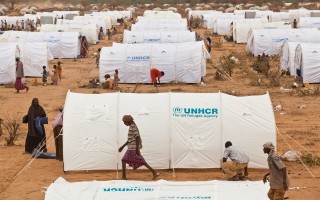This is a summary of what was said by UNHCR spokesperson Leo Dobbs – to whom quoted text may be attributed – at today’s press briefing at the Palais des Nations in Geneva.

Somali women displaced by drought and famine wait in line to collect UNHCR aid supplies at the Maajo IDP settlement in Mogadishu, Somalia in this 2011 file photo. © UNHCR/Siegfried Modola
Drought has displaced more than 135,000 people inside Somalia since November, according to data compiled by UNHCR, the Norwegian Refugee Council and community based organizations. Swift and substantial action and adequate funding are becoming urgently needed to avoid famine and a repeat of 2011, when some 250,000 people died, more than half of them aged under five years.
According to the authorities in Puntland, more than 20,000 families have moved to the Bari region. And 1,638 are in need of emergency assistance in the northern town of Galkayo.
People are leaving their homes because of the drought, rising food prices, dry weather forecasts, and ongoing insecurity and are heading for urban areas. This includes to Mogadishu and the town of Baidoa. The Government is seeking to have aid provided to people in their districts in order to avoid people making long a dangerous trip on foot in search of help.
There have been reports of deaths and illness, although these are not widespread. On Sunday, we received reports of 38 deaths due to drought-linked reasons in the Bakool region of South-Central Somalia. Medical cases include people with acute malnutrition, especially children, watery diarrhoea, and cholera. Detail is sparse.
Through an inter-agency response, UNHCR and partners are working to mitigate against a deterioration into famine. This includes tackling rising malnutrition, limiting displacement, and containing disease outbreaks and enhancing protection.
We have started helping the displaced in the worst affected areas – Puntland and Somaliland in the north, and the areas of Bay and Bakool. This includes through the provision of emergency shelter and aid items to thousands of people and through strengthened protection monitoring.
Some 1,000 aid kits are being sent to drought affected families in Mudug (Puntland), and preparations are under way to distribute 1,500 in Bari (Puntland), and truck water into areas of Somaliland. UNHCR is also providing help in shelter and distribution of aid items in Bari, Nugal (Puntland) and Sanaag (Somaliland) Galkayo and Garowe.
Drought is also pushing some to flee the country. Since the start of the year, more than 3,770 Somali new arrivals have been recorded at Melkadida in Ethiopia, and acute malnutrition has been reported in around 75 per cent of arriving child refugees. No substantial movement into Kenya has been reported so far.
The drought comes as UNHCR continues its voluntary repatriation programme for Somali refugees in Kenya’s Dadaab complex, which has brought home 49,985 people since December 2014. UNHCR is informing people in the camps about the drought, but so far this does not appear to have had a major effect on returns.
UNHCR and other humanitarian organizations are better prepared to respond than in 2011, but funding needs are urgent. For January–June, US$825 million is needed, but US$100 million has been pledged.
For more information on this topic, please contact:
In Geneva, Leo Dobbs, dobbs@unhcr.org, +41 79 883 6347
In Nairobi, Julien Navier, navier@unhcr.org, +254 732 400 044
Article originally posted on unhcr.org



